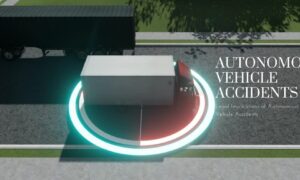Imagine a world where trucks drive themselves, and autonomous vehicles rule the road. Industry experts project autonomous vehicles will become more common over the next ten years. Already there are companies that operate autonomous trucks in select areas such as mines, to increase efficiency and safety. This trend is quickly spreading to other industries, including shipping and logistics. In this article, we will explore how drone mapping can improve self-driving trucks and autonomous trucks.
The need to improve safety and efficiency is leading many truck operators towards autonomous vehicles. According to a report from the American Transportation Research Institute, nearly four out of every five accidents involving large trucks were from driver-related errors such as fatigue and distraction. Autonomous trucks would reduce this number significantly because they cannot get tired or distracted.
Autonomous Innovations
Of course, safety and efficiency are not the only factors behind autonomous innovations in the trucking industry. With autonomous trucks, companies can increase their ability to carry cargo while also reducing traffic congestion. For example, autonomous trucks could drive autonomously long-distance drives while increasing their efficiency and decreasing idling time.
This is where drone mapping comes into play. Drone mapping can help autonomous vehicle operators improve safety by focusing on the surrounding environment during autonomous navigation. Drone mapping can also improve autonomous truck efficiency in several ways. First, autonomous trucking companies could use drones to conduct autonomous pre-delivery inspections.
Drone mapping provides autonomous vehicle operators with an immediate assessment of the surrounding environment when they arrive at their destination. This can help autonomous operators with navigation when unloading cargo, which reduces the risk of damage.
The Future of Drone Mapping
Although autonomous trucks are still in their early stages, they poised drone mapping to play an important role in improving safety and efficiency for autonomous vehicles across industries. Drone mapping gives autonomous vehicle operators a bird’s-eye view of surrounding environments before they start autonomous navigation, which reduces the risk of accidents.
If you are considering using drones for self-driving and autonomous vehicles, be sure to consult industry regulations about autonomous vehicles before starting your project. This way, you can ensure your autonomous vehicle solution will comply with all federal regulations.
What are Self-Driving Trucks?
Self-driving trucks make use of different sensors to identify the obstacles and guide it towards the location. The self-driving truck delivers several benefits, including improved safety features for both heavy machinery operators and other drivers on the road.
The self-driving truck technology currently has a human driver who monitors and controls the vehicle during its journey. The self-driving trucks make use of different sensors to identify the obstacles and guide it towards the location. Most self-driving truck delivers several benefits, including improved safety features for both heavy machinery operators and other drivers on the road.
These trucks deliver several benefits, including improved safety features for both heavy machinery operators and other drivers on the road. They navigate their routes without human input over longer distances than self-driving cars, where the self-driving truck remote control has to be within 1 kilometer of the self-driving truck’s location in order to remote control it.
How Do Self Driving Trucks Work?
Are you wondering how self-driving trucks work? Well, Self-driving trucks are self-propelled vehicles that can steer and brake on their own. Some may require a driver to take control in some situations, such as road construction.
Self-driving truck technology falls into two general categories: platooning and autonomy. Platooning is a system where multiple self-driving trucks follow the same set of directions at precise distances from each other. Autonomous self-driving trucks require no input from drivers and can navigate independently based on programmed route information.
In 2014, self-driving trucks were in various stages of development by various companies and organizations such as self-driving truck technology startup Peloton Technology and self-driving truck developer Robosoft Technologies. In September 2014, Peloton Technology tested self-driving trucks on the German Autobahn. By 2016, companies such as Uber Technologies and Google had tested self-driving trucks.
What Do You Expect from a Self-Driving Truck in the Future?
The self-driving trucks market is expected to rise in the future, with automated vehicles such as self-driving cars gradually gaining traction worldwide. The truck market emerged from the self-driving car market and is expected to grow at a CAGR of 12.76% from 2015 to 2021. With self-driving technology on the rise, self-driving trucks will likely see more demand.
In self-driving technologies, manufacturers make these trucks to provide a safer environment for truck drivers as self-driving cars could eliminate human error from driving. Through this technology, self-driving trucks would reduce accidents because of speeding and tailgating.
Self-Driving Trucks for Commercial Operations
Self-driving trucks are self-driven, motorized vehicles intended for commercial operations. manufacturers outfit them with both the equipment to move heavy goods and self-driving software that allows it to self-navigate without human interaction. As of now, these trucks are still in the development stage and not quite ready for full commercial use.
Most self-driving trucks offer several benefits to consumers, including better fuel economy and lower costs associated with operating them. These trucks are currently being developed by companies around the world.
How Self-Driving Trucks can benefit Your Economy
During the first six months of 2015, trucks carried roughly 10 billion tons of goods around the U.S. While self-driving technology may one day make trucking safer and more efficient for all parties involved, these trucks also introduce several legal and safety concerns that individuals must consider before self-driving trucks become commonplace on public roadways.
Most Self-driving trucks can also reduce the number of truckers employed by various companies, potentially affecting the economy. These trucks are self-driven, motorized vehicles intended for commercial operations. manufacturers outfit them with both the equipment to move heavy goods and self-driving software that allows it to self-navigate without human interaction.
If you are interested in learning more about self-driving trucks and autonomous vehicles, contact us today for a free consultation! We can help you determine the best drone mapping system to fit your needs. You can also subscribe to our blog for regular updates on autonomous drone applications, self-driving trucks, industry regulations, and other relevant news.



































